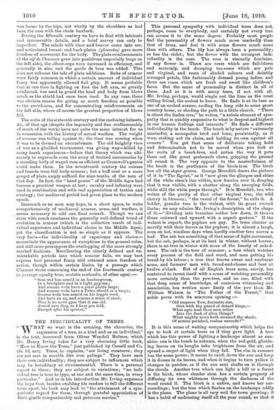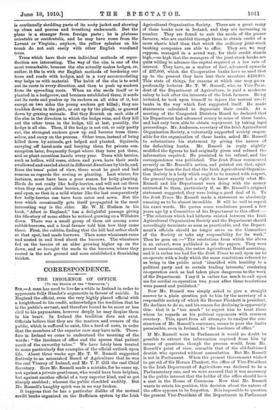THE INDIVIDUALITY OF TREES.
- " WHAT we want is the meaning, the character, the expression of a tree, as a kind and as an individual," is the text; borrowed from Oliver Wendell Holmes, which Mr. Henry Irving takes for a very charming little book, " How to` Snow the Trees," just published by Cassell and Co. (3s. 6d. net). Trees, he explains, " are living creatures ; they ' are not cast in moulds like iron palings." They have each
• their own individuality; they are subject to influences which may be hereditary or circumstantial. There is a personal aspect to them; they are subject to variations; "no indi- vidual tree is true to type, at one and the same time; in every particular." And so in his introduction Mr. Irving expresses
• the hope that, besides enabling his readers to tell the different trees apart, his book may lead to " the attainment of a um- ' pathetic regard for them, through • gratefal appreciation of
• their gentle Companionship and generous service:' This personal sympathy with individual trees does not, perhaps, come to everybody, and certainly not every tree can arouse it to the same degree. Probably most people feel the personality of flowers much more markedly than that of trees, and feel it with some flowers much more than with others. The lily has always been a personality; so has the violet; but the flower with the strongest indi- viduality is the rose. The rose is eternally feminine, if any flower is. There are roses which are full-blown and matronly, and drooping tea-roses which are pale and virginal, and roses of shaded colours and daintily arranged petals, like fashionably dressed young ladies, and there are roses which are fresh and sweet like children's faces. But the sense of personality is distinct in all of them. And so it is with many trees, if not with all.
Mr. Irving, perhaps, would single out the lime as the most willing friend, the easiest to know. He finds it at its best as
one of an arched avenue, roofing the long ride to some great country home, or shading the path to a little church. " There is about the linden tree," he writes, "a subtle element of sym- pathy that is quickly responsive to what is deepest and highest in our human feelings and interests." He finds a different individuality in the beech. The beech is by nature "extremely masterful, a monopolist bred and born, persistently, as it were, staking out its claim, and holding its own against all comers." You get that sense of deliberate taking hold and determination not to be moved when you look at the roots of a beech-tree, and notice the way it puts them out like great prehensile claws, gripping the ground all round it. The very opposite to the masterfulness of the beech is the gentleness of the birch-tree. The birch has all the shyer graces. George Meredith draws the picture of it in "The Egoist," as it "now gives the glimpse and shine of the white stem's line within, now hurries over it, denying that it was visible, with a chatter along the sweeping folds, while still the white peeps through." It is Meredith, too, who writes of the purity of that other virginal tree, the wild
cherry in blossom ; •" the vestal of the forest," he calls it. A bolder, grander tree is the -walnut, with its great curved
limbs; we may admire Mr. Irving's description of the shape of it,—" dividing into branches rather low down, it" throws these outward and -upward with a superb gesture." If the walnut is superb, the poplars are gay. No trees chatter so merrily with their leaves as the poplars; it is almost a laugh, even on hot, windless days when hardly another tree moves a leaf. The ash has something of that sense of light movement, but the ash, perhaps, is at its best in winter, without leaves ; there is no tree in winter with more of the beauty of naked- ness. The oak is the tree of summer; a tree which watches every process of the field and wood, and man getting his bread by his labour; a tree that knows sweat and sunburnt arms, and farmers' men with bread-and-cheese and beer at twelve o'clock. But of all English trees none, surely, has contrived to invest itself with a sense of watching personality more certainly than the yew-tree, and no one, filled with that deep sense of knowledge, of conscious witnessing and association, has written more finely of the yew than Mr.
William Watson in " The Father of the Forest,". that noble poem with its sonorous opening :— " Old emperor Yew, fantastic sire,
Girt with thy guard of dotard kings,—
What ages halt thou seen retire Into the dusk of alien things ?
What mighty news hath stormed thy shade, Of armies perished, realms unmade?'
It is this sense of waiting companionship which helps the eye to look at certain trees as if they gave light. A tree which has this power of lighting a landscape almost as sun- shine can is the beech in autumn, when the red-gold, glistdn-
ing leaves on its boughs take brightness from the air, and spread a carpet of light when they fall. The elm in summer has the same power; it seems to catch down the sun and keep it in domes in its leaves, and when it begins to turn yellow it changes in patches, as if the sun sent shafts on it through the clouds. Another tree which can light a hill or a forest is the birch, whose slender stem has a certain property of diffusing its own whiteness through the darkness of the wood round it. The birch is a native, and knows her sur-
roundings.; but the tree which flashes on the landscape oddly is the plane. The plane' is all very well for town growing; it c has a habit of undressing itself all the year round, so that it is continually shedding parts of its sooty jacket and showing up clean and porous and breathing underneath. .But the plane is a stranger from foreign parts ; he is plates= erientalis or oceidentalls, and he may have come from the Levant or Virginia; anyhow, the yellow splashes on his trunk do not suit easily with other English woodland trees.
Trees which have their own individual methods of repro- duction are interesting. The way of the elm is one of the most remarkable, because the elm actually makes hedges, or, rather, it fits in with our English methods of bordering our trees and roads with hedges, and in a very accommodating way helps us with material. The habit of the elm is to send out its roots in every direction, and then to push up suckers from its spreading roots. When an elm seeds itself or is planted in a hedgerow, and becomes established there, it sends out its roots and pushes up its suckers on all sides of it, but except on two sides the young suckers get killed; they are trodden down in the path, or cut up by the plough, or gnawed down by grazing animals But they flourish on each side of the elm in the direction in which the hedge runs, and they kill out the other trees in the hedge, till at last, possibly, the hedge is all elm. Then, if the hedge is not cut, or only partly cut, the strongest suckers grow up and become trees them- selves, and carry on the process. Other trees, instead of being killed down by animals, get helped and planted. Squirrels, carrying off hazel-nuts and burying them for private con- sumption later, frequently forget where they have put them, and so plant countless hazels every year. Trees with berries, such as hollies, wild roses, elders, and yews, have their seeds swallowed and carried about in different directions by birds, and, from the trees' point of view, there must be good and bad seasons as regards the sowing or planting. Last winter, for instance, must have been a poor season for holly-planting. Birds do not really like holly-berries, and will not eat theni when they can get other berries, or when the weather is warm and open, so that in a mild winter like the last comparatively few holly-berries can have been eaten and sown. But the tree which occasionally gets itself propagated in the most interesting way is the elder. Mr. W. H. Hudson in his book, " Afoot in England," has a delightful passage giving the life-story of some elders he noticed growing on a Wiltshire down. There was a small group of them set among some rabbit-burrows, and a local farmer told him how they came there. First, the rabbits, finding that the bill had softer chalk at that spot, had made burrows. Then some wheatears came and nested in and lived about the burrows. The wheatears fed on the berries of an elder growing higher up on the down, and so brought the seeds to the burrows, where they rooted in the soft ground and soon established a flourishing thicket.











































 Previous page
Previous page